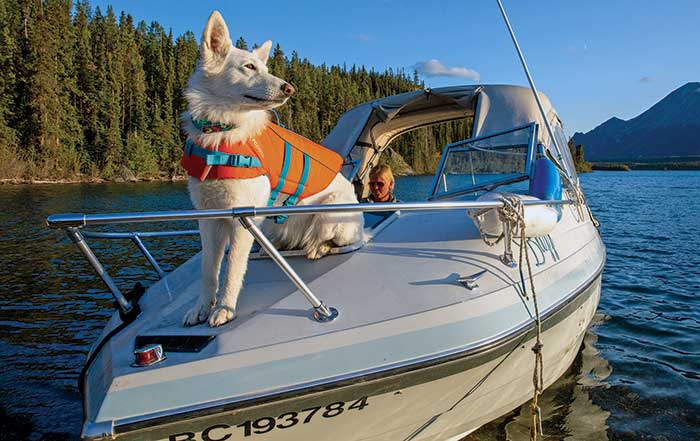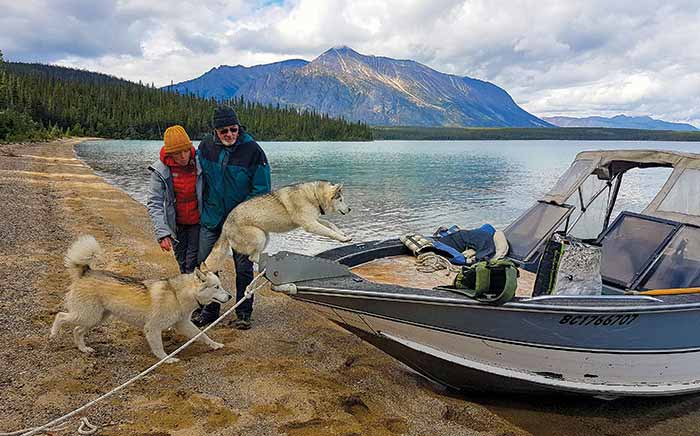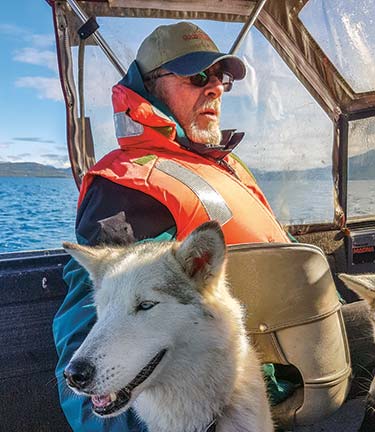Advertisement
Dispel doggy anxiety afloat and teach your pup to love boating.

Spending time preparing your pet for boating is the key to making it a positive and fun experience for him. (Photo: Manu Keggenhoff)
Eager to hit the water on the first day of the season, we briskly launched our 17-foot Tracker at the boat ramp, bringing our two huskies, Freya and Meryn, along for the ride. As our 75-hp roared to life, Meryn began drooling. Though my husband and I tried to comfort her, we made it less than 10 miles before she spewed her breakfast across the deck. As I searched the lockers for paper towels, I wondered what had gone wrong. Freya seemed perfectly at ease. Was Meryn nervous? Seasick?
In our hurriedness to go boating, we hadn't considered that this was likely Meryn's first time on a powerboat (we'd adopted her that year). So, back on land, I reached out to Cathy Madson, a CBCC-KA and CPDT-KA certified dog trainer at PreventiveVet.com, to learn how to ensure good boating experiences for human and canine crew alike.
Twin Trends — Dogs And Boats
Americans went mad for dogs and boats in 2020. So we shouldn't be surprised to see more salty dogs on the water this summer. With many folks stuck at home and looking for company, demand for "pandemic pups" soared. Rescue organizations, breeders, and pet stores reported that the demand often outstripped supply. Simultaneously, boat sales skyrocketed as people looked for socially distanced recreational opportunities. According to Vicky Yu, director of business intelligence for the National Marine Manufacturers Association (NMMA), "We expect to close out 2020 with more than 300,000 new boats sold — levels the industry hasn't seen since before the Great Recession in 2008–2009."
Safety First
It turns out the mistake we made is common. "One of the biggest problems is not taking the time to prepare our dogs for boating," says Madson. "It can be so tempting for us to just grab our dogs and go for a boat ride, but it's important to make sure our dogs are ready and that they'll actually enjoy it. That way we can enjoy it and not find ourselves in a really stressful or frustrating situation." Or, in my case, cleaning up half-digested kibble.
A nervous or overexcited dog can present safety issues for human and canine crew members alike. "An anxious dog might try to escape, which could lead to them going overboard," explains Madson. "An overexcited dog might jump off the boat because they love the water, or jump all over their owner who is trying to steer the boat."
From the dog's perspective, it's easy to see why boating might bring on anxiety or excitement. "Being on a moving boat is such a different experience for dogs," says Madson. "The moving and slippery surfaces, the sound of the motor or the sails in the wind — these can be really overwhelming." Fortunately for myself and other dog owners, a bit of preparation can go a long way.
Dog Overboard!
Do you have a dog overboard plan? Similar to man-overboard (MOB) recovery, DOB procedures should be established and then practiced routinely. "I always have people practice it before it's an actual emergency," says Madson.
"If the dog falls overboard or jumps out, you always want to first cut the engine," she explains. "Go to the loading spot, call them from the water, then help them get back in."
Dry-Land Training
Before you start, Madson recommends knowing a few basic training fundamentals. For instance, teaching your dog to focus on you. "That way you can ask for their attention and you know they're listening," says Madson. The dog should also come when called before going on a boat. "It's so important for water safety and should be practiced first on land and then on the water."
As a first step, she suggests training your dog to lie down and stay on a nonslip mat on dry land. Then when you bring the mat on the boat, they'll have a place to "relax and stay out of the way when you're navigating and underway."
It also helps to get your dog comfortable with wearing a life jacket before asking them aboard. Madson recommends life jackets for all dog breeds: small or large, water-loving or not. "They can get tired, they can get cold, they might even get injured, and they need to be wearing a life jacket," she says.
It hadn't occurred to me that our hearty huskies might not be able to swim out of an emergency situation. After chatting with Madson, doggy life jackets went on the shopping list.
Do Dogs Get Seasick?
"Yes," says Madson. "We see it a lot with young puppies because their inner ear is still developing and their balance is off. If they get seasick as puppies, they might connect that feeling with being on a boat as they mature. That can create anxiety outside of the nausea. Sometimes puppies grow out of it. We just want to make sure they don't see being on the boat as an unpleasant experience because they felt sick before."
If your dog is exhibiting seasickness, Madson suggests talking to your veterinarian. "If you're noticing some seasickness, there are some great medications out there. They might also have some suggestions on supplements that could help."
Getting In And Out Of A Boat
Training your dog how to get in and out of a boat may vary depending on your dog's size, boat type, and mooring situation. Madson suggests, when possible, to "practice loading and unloading on dry land before introducing the instability of the boat on the water."
Make the practice realistic. "If there's a step or ramp, then practice using that as well," she says. "Especially when they're coming out of the water into the boat. If you have a ladder, teach them what it's for."

Photo: Fiona McGlynn
With small dogs, Madson recommends picking them up and carrying them on and off the boat. "That way they're not likely to slip between the dock and the boat," she says.
Additional training is necessary with larger dogs that can't be easily picked up and carried around. Madson suggests picking a calm day (if you're working on the water) and using what's called the lure-and-treat method. "I have a really tasty treat in my hand, and I help guide them toward the boat," says Madson. "If they take a step onto the boat, I give them that treat and then I repeat."
Tip
While it may be tempting to be bolstered by early successes, Madson suggests going slow and at the dog's pace. "I like to reward the small steps of the process and keep the training short and sweet. If they get all four paws on the boat, I have a treat party. Chicken just rains from the sky!"
It's especially important to slow things down if the dog tends toward overexcitement. "Some dogs are just ready to rock and will leap aboard or back onto the dock," says Madson. "In that scenario, I focus on teaching a calm get-on and get-off, so it's safer and they don't slip or fall. I lower my treat, and I make it a lot slower for them."
"With repetition, they start to understand what we want when we use a hand to point onto the boat or onto the dock," says Madson, "and that's when I add a verbal cue like 'all aboard.'"
Dog Life Jacket Shopping Tips
Dog owners love to brag about how good their pooch can swim, but even true "water dogs" can only doggie paddle for so long before exhaustion sets in and drowning becomes imminent. Although it's not a legal requirement, BoatUS encourages all boaters to outfit their dogs with a life jacket — and put it on them every time — whether on the docks or out on the water.

To zero in on the perfect size for your pooch, use a ribbon-like tailor's tape to take the following measurements: 1. Girth (most important) — dog's chest at the widest point just behind the front legs, 2. Neck — around the base of at the widest point, 3. Length — base of neck (at the bottom of the collar) to base of tail Write down these three measurements, along with your dog's weight, since they'll help you determine which size to order. Just like for human wardrobes, "medium" in one manufacturer may be different from another.
There are well over a dozen brands of canine life jackets, each with its own design details. Unlike human life jackets, where Coast Guard certification is the gold standard, there are no standards for dog life jackets. Here are some features you should look for:
- Handle(s): Regardless of size, chances are you'll have to lift your dog out of the water and back onto the boat. Most brands have a handle on the top center of the jacket aligned with your dog's spine, so you can pick him up (like a briefcase). Some designs for larger dogs incorporate two handles. Keep in mind the added weight of a wet dog. Check the handle stitching (preferably double stitching), since it's going to be put under a lot of strain.
- Buoyancy: Superior dog life jackets have flotation under the belly as well as on the back and sides. Some jackets have flotation sections under the neck to help keep your dog's head above water.
- Color: Earth tones may look cooler on your boat, but should your four-legged buddy go overboard, high visibility is essential. Bright colors, preferably with a reflective strip, make a dog easier to spot in the water.
- D-ring: This is a nice feature to look for, so you can attach a leash.
- Straps: In general, the more adjustments, buckles, and closures, the better the final fit. Touch tape closures work well, and they're easier to put on and take off, but consider that they tend to attract hair/fur and need cleaning so they maintain their cling. For straps, the wider the better, since they're less likely to chafe your dog. Straps under the belly should be padded. And you don't want an excessively long dangling straps after fitting, since they're just asking to be chewed or could get tangled on something.
- Size and fit: Make sure you're purchasing a dog life jacket that is the proper size for your dog, so a prepurchase fitting is ideal. Stores like West Marine, Petco, and PetSmart allow customers to bring in their dogs to try on life jackets.
— Rich Armstrong
Riding In A Boat

Man’s best friend afloat. The author's dad, Ian McGlynn, with her
dog Meryn, who now loves a day on the water. (Photo: Fiona
McGlynn)
Once you've trained your dog to get on or off the boat, the next step is teaching them to calmly settle in a designated spot. "That's where that nonslip mat really comes in handy," says Madson. "It helps the dog feel a lot more secure because boat surfaces can be slippery, and when the boat is moving, the dog may feel off balance."
With your nonslip mat in place, begin training them to settle. "Teach them to go to this mat, lie down, and then work on a stay," says Madson. "I first practice that without turning the engine on."
To make it a rewarding experience for the dog, offer treats throughout. "Drop treats between their paws," she says. "That prevents an excited dog from getting in the way and can help anxious dogs feel like this is a safe spot." The goal is "teaching that calm, settled behavior and slowly building them up to the boat moving and more noises while always keeping it short and fun for them."
What To Pack In Your Dog's Boat Bag
- Dog life jacket
- Plenty of fresh water and a water bowl
- Dog first-aid kit
- Nonslip mat
- Potty pads or portable real grass alternatives like Fresh Patch
- A dog-safe sunscreen
- A portable canopy for shade
What If My Dog Is Very Fearful?
In cases where a dog is showing a lot of anxiety or fear onboard, Madson suggests taking a step back. "The first thing I think about is whether it's a good idea to bring that dog along on boating trips," says Madson. "If they're happier on dry land and at home, it is OK to go boating without them, and they'd probably prefer it."
For those boaters who need to bring their dog boating because they're going on a long trip or don't have a pet sitter, Madson suggests working on what's called counter-conditioning and desensitization. "Those are big, sciencey words, which is why connecting with a certified trainer makes it so much easier," says Madson. "It's a big behavior plan and the goal is to change your dog's emotional response to being on the boat."
Since we started to employ Madson's techniques, our dog Meryn is becoming more comfortable aboard. While she's yet to catch the boating bug, she seems happy enough to go out on the lake and is no longer displaying signs of anxiety while we run the motor. In the end, we learned that, similar to taking a human boating for the first time, bringing a dog aboard should be a slow, safe, controlled experience, designed with their comfort and enjoyment in mind. With any luck, those positive experiences will be the first of many fun-filled days afloat with our canine pals.
